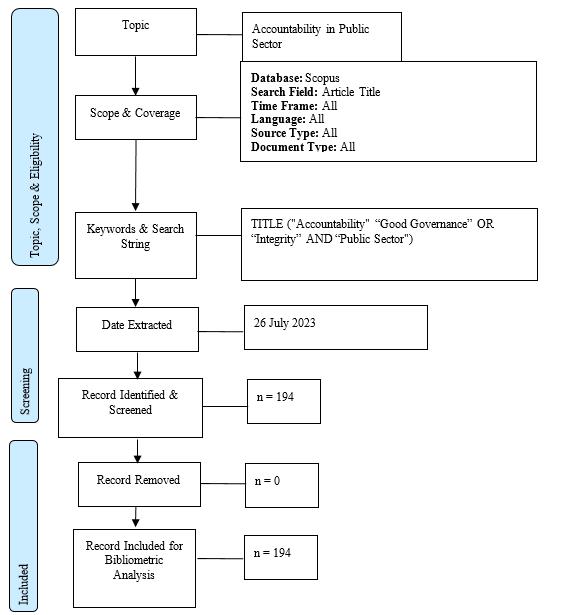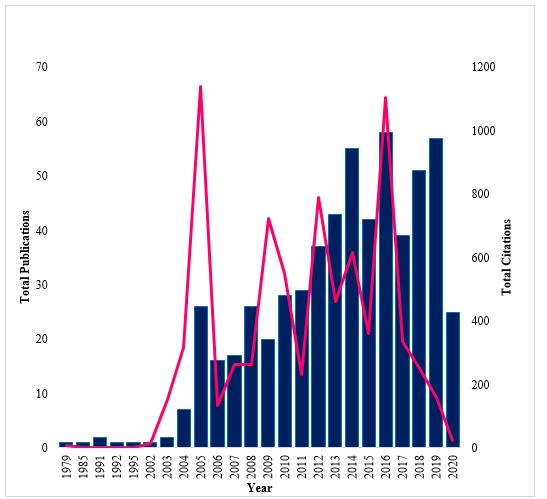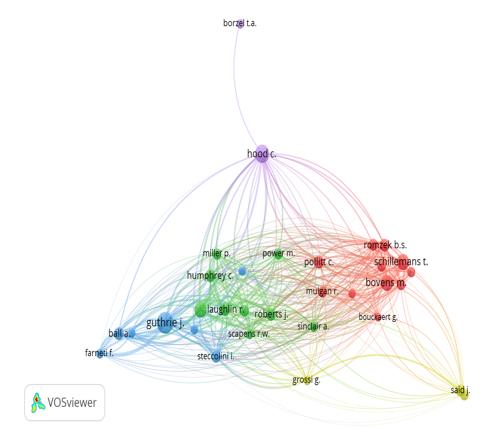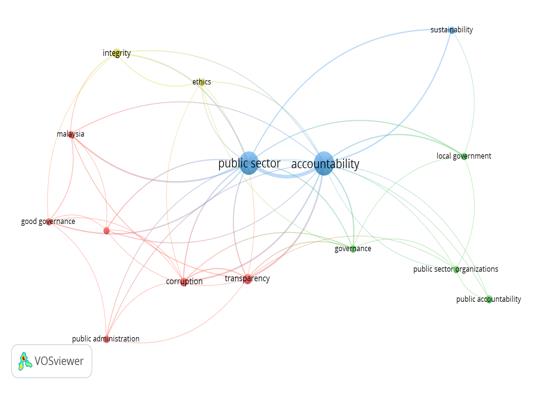Abstract
Keywords: Accountability, Bibliometric Analysis, Citation Analysis, Governance, Public Sector
Introduction
Accountability is the foundation of trust between public institutions and society (Kluvers, 2003) and is a mechanism that makes organisations answerable to the public (Bovens, 2007). It is the duty of the government to provide its citizens with regular updates on its performance (Barton, 2006). In a similar vein, those entrusted with the management of public institutions on behalf of citizens must account for the use of public funds (Kluvers, 2003). Actions taken by the government have far-reaching consequences for the economy and society at large (Herawaty & Hoque, 2007). Therefore, government officials who handle public funds and policy should be held accountable (Boyne & Law, 1991). Governments around the world place a premium on public officials' honesty and transparency when providing public services (Khanal et al., 2022). The overarching goal is to ensure that public sector employees are accountable for their actions and are acting with integrity as they go about their daily business (Sajari et al., 2023) in order to safeguard the public interest.
Furthermore, accountability is a standard for fraud prevention and control techniques (Evans, 1999), making it an important factor for organisations in the public sector. It also includes measures taken to prevent fraud from occurring within or affecting the relevant organisations with access to public monies. Since this issue has recently gained widespread interest, governments, professionals, and academics have all called for greater responsibility (Coy & Pratt, 1998). However, prior to the 21st century, there was a dearth of scholarly investigation of public sector accountability, with the earliest work on the topic being in 1980. Not only is there no study on accountability in the public sector, but there are also very few bibliometric evaluations of accounting and accounting research related to the public sector available on Scopus. Therefore, the purpose of this research is to do a bibliometric analysis of the articles in the Scopus database. The study is comprehensive, including all time periods and subject areas for which Scopus data is available. Scopus is selected as the database of choice because it is recognised to contain scholarly writings.
Therefore, the following research questions are answered in the paper: What is the present status of research on Public Sector Accountability, Good Governance, and Integrity? When it comes to accountability, good governance, and integrity in the public sector, which papers have received the most citations? Response to Question 3: Who are the leading authors on the topic of public sector accountability, good governance, and integrity? Research Question 4: Which nations and organisations have produced the most works on Public Sector Accountability, Good Governance, and Integrity? RQ5: Within the realm of Accountability, good governance, and integrity in the Public Sector, what are the most often explored areas based on Keywords? As for the rest of the paper, the outline looks like this: The literature review can be found in Section 2, followed by an explanation of the technique used to analyse the existing literature in Section 3, the analysis's results in Section 4, and a discussion and conclusion in Section 5.
Literature Review
It's not easy to pin down exactly what accountability is because so many scholars have debated the topic at length. The term "accountability" is sometimes used interchangeably with "good governance," and it also refers to such concepts as "responsibility," "integrity," and "transparency" (Seda & Tilt, 2023). Accountability, as defined by Kohler and Dimancesco (2020), is "a system that makes individuals or institutions accountable to, or responsive to, a defined public." Accountability, as defined by Johari et al. (2021), means that an individual or group must give a just account of their acts, take full responsibility for them, and be forthright about the results.
As defined by Besley (2008), accountability refers to the extent to which public servants are responsible for the outcomes of their activities and decisions. Part of being accountable is being able to determine if someone's performance satisfies the needs of others and advances organisational goals (Rajala & Kokko, 2022). Therefore, accountability means taking ownership of one's behaviour in relation to these expectations and being subject to consequences for failing to meet them (Wu & Christensen, 2021). Therefore, accountability can be defined as the internal and external obligation of an individual or organisation to account for their actions, accept responsibility for them, and honestly reveal the consequences, such as the responsibility for money or other entrusted property (Almquist et al., 2013; Aziz et al., 2015; Huse, 2005; Johari et al., 2021; Iyoha & Oyerinde, 2010).
Transparency, accountability, and responsible leadership in the public sector are essential for long-term economic expansion and social harmony (Hu, 2017). These principles are fundamental to an effective management framework in the public sector (Tiki et al., 2022) because they encourage honesty and transparency while simultaneously decreasing the likelihood of dishonest or corrupt actions. Providing an account or report on the nature of how obligations have been carried out is what Effendi (2002) calls "accountability" for public administrations. This pledge is made to improve the performance of these institutions and to create a set of mechanisms and components that will ensure honesty and openness, the elimination of graft in the public and private sectors, and the defence of the public interest. Being accountable to other people, or answerability, is one aspect of accountability, while managing others' expectations of appropriate behaviour, or expectation management, is another (Rajala & Kokko, 2022).
Since access to information is recognised as a basic human right (Hazelton, 2013), and since the public has a right to be informed (Barton, 2006), public accountability is essential in the public sector. As the most all-encompassing interpretation of the accountability paradigm, "public accountability" means that governments are obligated to make decisions that benefit the public as a whole in accordance with established norms, standards, and procedures (Funnell, 2003). A strong and efficient government is essential to achieving this mission of serving the public interest and protecting citizens' rights (Aziz et al., 2015). To do this, government officials must be transparent about how they use tax dollars and honest in their pursuit of solutions that benefit everyone (Johari et al., 2021). Therefore, public sector accountability is particularly important for the smooth running of government agencies.
Methodology
On July 26, 2023, we queried Scopus for the relevant data that was used in this article. "accountability" OR "good governance" OR "Integrity" AND "Public Sector" were used as keywords to search the database, which was then filtered by the article's title. According to Seda and Tilt (2023), we chose these terms since accountability is often interchanged with good governance and integrity. To get the most relevant results, we didn't restrict our search by time, language, or topic. There were 194 relevant results returned by the query. See the procedure flowchart in Figure 1 below for how to search the Scopus database. VOSViewer was used to do the bibliometric analysis. In addition, the citation metrics and other frequencies were collected using the Harzing Publish or Perish software. Some calculations and graphs were also made using Microsoft Excel.

Results
The bibliometric analysis in this study looked at information such the publication's year, authors, subject area, document type, title, author-chosen keyword, author-affiliated institutions, country of publishing, source type, and language. To further aid in understanding the data, citation metrics and frequencies were calculated to probe the typical citation of the publication. Data frequencies are shown both numerically and graphically.
Research Trends
Figure 2 below depicts the publication trend of accountability in the public sector. The data reveals that the first publication on the research area was in 1980, titled “Accountability, responsiveness and public sector productivity” by W.A. Baker. Total publications during the year reached a two-digit figure first time in 2010, followed by 2015, 2017, 2018, 2020 and 2021 with 11, 14,12, 16, 12 and 11 publications respectively. As can be seen, there is an increase in the average number of publications from 2015 onwards. The figure below also shows the total number of publications and citations per year.

Table 1 below shows the top 5 countries that contribute to the publications related to the research topic. The authors from the United Kingdom contribute 39 (20.10%) publications. Next are authors from Australia with 30 (15.46%) publications, followed by authors from the United States and the Netherlands with 21 (10.82%) publications and 13 (7.22%) publications, respectively.
Table 2 presents the results for the most influential institutions in the publication of the research area, with more than three publications. The results reveal that two Malaysian institutions top the first two positions as the most influential institution.
Citation Analysis
The significant impact of publications concerning the research area is examined by conducting citation analysis. Citation analysis computes and analyzes the number of citations by other's work. Harzing’s Publish or Perish was used to compute the citation metrics. Table 3 displays the citation metrics for 194 documents in the research area. The documents are cited 4387 times. It demonstrates that from 1980 to 2023 (43 years), there is an average of 102.02 citations per year, with the average number of citations per paper being 222.61.
Table 4 presents the list of highly cited articles led by Heinrich (2002) with a total cites of 302 cites per year of 14.38 followed by Romzek (2000) with 213 cites.
Table 5 below shows the most productive author in the research area with four or more publications. The analysis revealed that the most productive authors in the research area are Alam, M.M. and Said, J., with a total of 6 publications accumulating 100 cites with an h index of 5 followed by Schillemans, T. with a total of 4 publications. All the other authors in the database have 2 or fewer publications to their name.
Figure 3 exhibits the visual map of co-citation based on cited authors. The minimum number of citations of an author is set at 20. A total of 32 authors met this threshold as shown in the figure below. Guthrie J. is the author with the highest link strength.

Keywords
Table 6 below shows the top keyword with more than five publications is accountability, which has 55 total publications and the public sector, with 55 total publications. However, the least keywords are Malaysia, governance, and good Governance, with only 6 total publications.
Figure 4 illustrated the network visualisation map of the author keywords based on title fields. The blue lines depict accountability and the public sector, while the green lines and yellow lines depicted governance and integrity respectively. The red lines reflect the research done on areas with regard to transparency and corruption. This figure helps to visualise associated keywords for publication.

Discussion and Conclusion
In total, the paper answers five questions. Scopus articles in this area of study are few and far between, according to the data, although there has been an upward trend since 2015, with a peak of 16 documents published in 2018. Heinrich (2002) essay has been cited 302 times; this yields an annual citation rate of 14.38; Romzek's (2000) piece, in second place, has been quoted 213 times. Alam, M.M., and Said, J., both from Malaysia and associated with Universiti Utara Malaysia and Universiti Teknologi MARA, respectively, have authored the most papers, with a combined six publications that have received a total of one hundred citations and a h index of five. Except for Schillemans, T., every other author in the database has only two or fewer works in the database under their name. However, British authors publish more articles than any other nationality, followed by Australians and Americans. This shows that studies of public sector accountability, good governance, and integrity are still predominantly conducted in industrialised nations. With a total of thirteen publications, Malaysia is the only developing country to make it into the top 10 countries that contributed to publishing in the research domain. Accountability and the public sector are the most studied topics within the realm of good governance and integrity in the public sector, with transparency, integrity, corruption, and public accountability close behind. This demonstrates that these terms, which typically pertain to governance and fraud mitigation, are the primary foci of the study in this domain. More research based on and created by writers from developing nations is needed to improve the extant literature on the accountability of the public sector, as significant levels of fraud within the public sector are observed in these countries.
The report contributes significantly to the existing body of knowledge by assessing the trend of accountability of public sector research over the past 43 years. Given the significance of the research topic, it is concerning that there is a publication gap between relevant articles from developing nations and the total number of publications in the study subject.
Despite this, papers from other sources were not included in the analysis because it is limited to the Scopus database. Keywords chosen to search the Scopus database are also a constraint on the analysis. If the keywords are changed, the analysis could be completely different. Database searches, multiple combination analyses, and bibliometric analysis are only a few examples of various methodological techniques that could be used in future studies. Research in the future could improve on this by including a more comprehensive literature review and expanding the scope of the analysis. The challenges of instituting accountability in the public sector might also be investigated by scholars.
Acknowledgement
We would like to thank Universiti Teknologi MARA for supporting this study.
References
Almquist, R., Grossi, G., van Helden, G. J., & Reichard, C. (2013). Public sector governance and accountability. Critical Perspectives on Accounting, 24(7-8), 479-487.
Aziz, M. A. A., Rahman, H. A., Alam, M. M., & Said, J. (2015). Enhancement of the Accountability of Public Sectors through Integrity System, Internal Control System and Leadership Practices: A Review Study. Procedia Economics and Finance, 28, 163-169.
Barton, A. D. (2006). Public sector accountability and commercial-in-confidence outsourcing contracts. Accounting, Auditing & Accountability Journal, 19(2), 256-271.
Besley, T. (2008). Issue Unbundling via Citizens' Initiatives. Quarterly Journal of Political Science, 3(4), 379-397. https://doi.org/10.1561/100.00008059
Bovens, M. (2007). Analysing and Assessing Accountability: A Conceptual Framework. European Law Journal, 13(4), 447-468. https://doi.org/10.1111/j.1468-0386.2007.00378.x
Boyne, G., & Law, J. (1991). Accountability and Local Authority Annual Reports: The Case Of Welsh District Councils. Financial Accountability and Management, 7(3), 179-194.
Coy, D., & Pratt, M. (1998). An insight into accountability and politics in universities: a case study. Accounting, Auditing & Accountability Journal, 11(5), 540-561.
Effendi, H. (2002). Public Administration Theoretical Framework–Approaches to Development and Important Issues in Practice. Cairo University.
Evans, H. (1999). Parliament and Extra-Parliamentary Accountability Institutions. Australian Journal of Public Administration, 58(1), 87-89.
Funnell, W. (2003). Enduring fundamentals: constitutional accountability and auditors-general in the reluctant state. Critical Perspectives on Accounting, 14(1-2), 107-132.
Hazelton, J. (2013). Accounting as a human right: the case of water information. Accounting, Auditing & Accountability Journal, 26(2), 267-311.
Heinrich, C. J. (2002). Outcomes-Based Performance Management in the Public Sector: Implications for Government Accountability and Effectiveness. Public Administration Review, 62(6), 712-725.
Herawaty, M., & Hoque, Z. (2007). Disclosure in the annual reports of Australian government departments: A research note. Journal of Accounting & Organizational Change, 3(2), 147-168.
Hu, C. (2017). Accountability of Public Servants under Dominant Political Settlements of China: Effects, Challenges, and Issues. International Journal of Public Administration, 40(3), 240-255.
Huse, M. (2005). Accountability and Creating Accountability: a Framework for Exploring Behavioural Perspectives of Corporate Governance. British Journal of Management, 16(s1), S65-S79.
Iyoha, F. O., & Oyerinde, D. (2010). Accounting infrastructure and accountability in the management of public expenditure in developing countries: A focus on Nigeria. Critical Perspectives on Accounting, 21(5), 361-373.
Johari, R. J., Alam, M. M., & Said, J. (2021). Empirical assessment on factors contributing to integrity practices of Malaysian public sector officers. Business Process Management Journal, 27(4), 1217-1237.
Khanal, R., Gupta, A. K., & Bhattarai, P. C. (2022). Civil servants' integrity in public sector: the case of Nepal. Heliyon, 8(12), e12632.
Kluvers, R. (2003). Accountability for Performance in Local Government. Australian Journal of Public Administration, 62(1), 57-69.
Kohler, J. C., & Dimancesco, D. (2020). The risk of corruption in public pharmaceutical procurement: how anti-corruption, transparency and accountability measures may reduce this risk. Global Health Action, 13(sup1), 1694745.
Rajala, T., & Kokko, P. (2022). Biased by design - the case of horizontal accountability in a hybrid organization. Accounting, Auditing & Accountability Journal, 35(3), 830-862. https://doi.org/10.1108/aaaj-11-2019-4272
Romzek, B. S. (2000). Dynamics of Public Sector Accountability in an Era of Reform. International Review of Administrative Sciences, 66(1), 21-44. https://doi.org/10.1177/0020852300661004
Sajari, A., Haron, H., Ganesan, Y., & Khalid, A. A. (2023). Factors influencing the level of ethics and integrity in Malaysian public sector. Journal of Islamic Accounting and Business Research, 14(1), 141-158.
Seda, L., & Tilt, C. A. (2023). Disclosure of fraud control information in annual reports as a means of discharging public accountability. Journal of Financial Crime, 30(2), 464-493.
Tiki, S., Luke, B., & Mack, J. (2022). Examining bribery in Papua New Guinea's public sector: forms and accountability implications. Journal of Public Budgeting, Accounting & Financial Management, 34(1), 96-119.
Wu, S., & Christensen, T. (2021). Corruption and Accountability in China's Rural Poverty Governance: Main Features from Village and Township Cadres. International Journal of Public Administration, 44(16), 1383-1393.
Zakaria, R., Ahmi, A., Ahmad, A. H., & Othman, Z. (2021). Worldwide melatonin research: a bibliometric analysis of the published literature between 2015 and 2019. Chronobiology International, 38(1), 27-37.
Copyright information

This work is licensed under a Creative Commons Attribution-NonCommercial-NoDerivatives 4.0 International License.
About this article
Publication Date
15 November 2023
Article Doi
eBook ISBN
978-1-80296-130-0
Publisher
European Publisher
Volume
131
Print ISBN (optional)
-
Edition Number
1st Edition
Pages
1-1281
Subjects
Technology advancement, humanities, management, sustainability, business
Cite this article as:
Rasheed, F., Said, J., & Khan, N. I. (2023). Mapping the Landscape of Accountability in the Public Sector: A Bibliometric Review. In J. Said, D. Daud, N. Erum, N. B. Zakaria, S. Zolkaflil, & N. Yahya (Eds.), Building a Sustainable Future: Fostering Synergy Between Technology, Business and Humanity, vol 131. European Proceedings of Social and Behavioural Sciences (pp. 936-946). European Publisher. https://doi.org/10.15405/epsbs.2023.11.77

